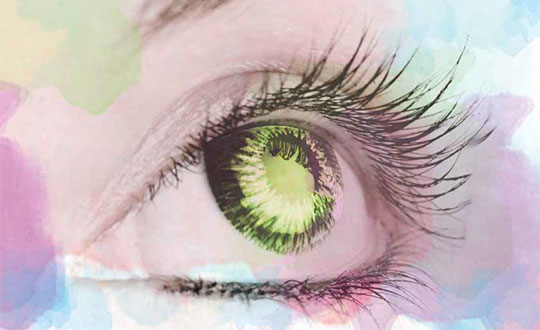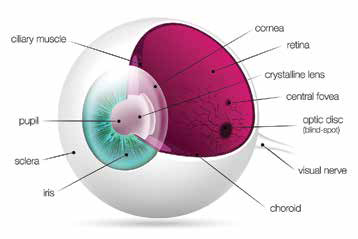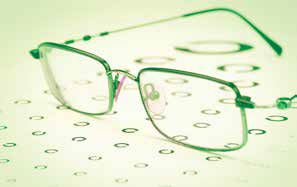
Few people take their eyesight for granted, but did you know that most eye conditions and mishaps are preventable? Here are ways to ensure your eyes—and those of your family—remain healthy throughout life.
The early years
The Canadian Association of Optometrists recommends that babies have their first eye exam between the ages of six and nine months. Children should have at least one eye exam between the ages of two and five, and yearly after starting school.
Eye injuries
Eye injuries are the most common preventable cause of blindness in children. Accidents around the home, outdoors, and during sports pose the primary risk to your child’s eyesight. Always make sure your child wears appropriate eyewear for sporting activities.
 Should something small enter your child’s eye, such as grit or sand, make sure he does not rub at it, or try to remove the object. You can attempt to flush it out using lukewarm water, tilting your child’s head sideways over a sink or bowl with the affected eye downwards. Gently pull down the lower eyelid before flushing and encourage your child to keep his eye as wide open as possible. With younger children, it helps to have someone assisting you. Flush the eye at regular intervals until the object is removed.
Should something small enter your child’s eye, such as grit or sand, make sure he does not rub at it, or try to remove the object. You can attempt to flush it out using lukewarm water, tilting your child’s head sideways over a sink or bowl with the affected eye downwards. Gently pull down the lower eyelid before flushing and encourage your child to keep his eye as wide open as possible. With younger children, it helps to have someone assisting you. Flush the eye at regular intervals until the object is removed.
In the event of a more serious accident to the eye, be sure to restrain your child and never attempt to remove an object such as a nail or piece of glass. Instead, call an ambulance, or get your child to the nearest emergency department. You might try taping a small cup over the affected eye to protect it.
Pink eye
Properly termed conjunctivitis, pink eye can affect people of all ages. However, it is particularly common among young children and can spread quickly in daycare and school settings.
Pink eye is an inflammation of the conjunctiva—the clear membrane that covers the white part of the eye and the inner surface of the eyelids. It can develop rapidly and give the appearance of being very painful, although it usually produces mild discomfort.
The inflammation can be caused by a number of bacteria and viruses (such as those responsible for colds or ear infections) and also by allergens such as pollen and ragweed. Environmental pollutants such as cigarette smoke can also cause pink eye.
If you suspect your child may have pink eye, it is best to take her to the doctor. Although pink eye caused by viruses frequently clears up on its own, bacterial pink eye usually requires a course of antibacterial eye drops. Teach your child not to touch the sore eye as this could spread infection to the other eye or to another person.
Since pink eye is contagious, schools and daycare centres normally request that a child experiencing the condition stay home until it has cleared up.
Adulthood
A number of conditions can affect the eyesight in adults— particularly older adults. These include glaucoma, cataracts, macular degeneration and diabetic retinopathy. Early recognition of these conditions is important to prevent or delay progression.
Cataracts
Cataracts are the most common cause of vision loss in people over age 40 and the principal cause of blindness in the world. Cataracts usually develop slowly, and progressively cause a decrease in the ability to see clearly
To enable sight, light rays penetrate the lens and focus onto the light-sensitive retina at the back of the eye. The lens mostly consists of water and protein. The protein is arranged in a precise pattern that keeps the lens clear, allowing light to pass through it.
A cataract forms when some of this protein clumps together causing small areas of the lens to cloud over. Over time, these areas grow larger and cloud more of the lens, making it harder to see.
 Eventually, the elastic lens of the eye thickens and becomes opaque, blocking the passage of light. This results in dulled, fuzzy vision. At this stage, corrective glasses or contact lenses may help. A “ripe” cataract—the term given to one that has progressed to the point of severely blocking light—can result in impaired vision requiring surgery. (Surgery can, however, be performed before a cataract reaches this stage.)
Eventually, the elastic lens of the eye thickens and becomes opaque, blocking the passage of light. This results in dulled, fuzzy vision. At this stage, corrective glasses or contact lenses may help. A “ripe” cataract—the term given to one that has progressed to the point of severely blocking light—can result in impaired vision requiring surgery. (Surgery can, however, be performed before a cataract reaches this stage.)
Other changes that signal the presence of a cataract include glare (particularly when driving at night), frequent changes in your eyeglass prescription, a decrease in colour intensity, yellowing of images, and—rarely—double vision.
Cataract surgery is very successful in restoring vision. The procedure involves removing and replacing the clouded lens with a clear, plastic intraocular lens (IOL). People who have cataract surgery normally regain very good vision, between 20/20 and 20/40.
Risk factors for cataracts include smoking (chemicals in cigarette smoke are believed to cause oxidation of the lens), the use of certain medications such as corticosteroids and statins, exposure to UV light (sunlight), family history of cataracts and being over 40.
You can reduce your risk of cataracts by wearing sunglasses in bright weather. Some evidence exists to suggest that a diet rich in antioxidants (from fruits and vegetables) can slow clouding of the lens.
Glaucoma
Glaucoma is a serious condition usually associated with increased pressure inside the eye that worsens over time. This pressure can cause damage to the optic nerve, which transmits images to the brain. If the high intraocular pressure continues, it can cause permanent loss of vision. For this reason it is important to have your eyes tested regularly as there are no early symptoms associated with glaucoma.

How often should you get your eyes tested?
Children should have at least one eye exam between the ages of 2 and 5, and yearly after starting school.
Adults aged 19 to 64 should have an eye exam at least every two years, and people with diabetes should have an exam at least once a year.
At age 65 and older, adults should have an eye exam at least once a year.
The risk factors for glaucoma include a family history of the condition; being over 60; being of African or Mexican heritage; having diabetes, heart disease, high blood pressure or hypothyroidism; having a past eye injury, and long-term use of corticosteroids.
While it is not easy to prevent glaucoma, you should make sure you have your eyes tested regularly, particularly after age 40. Your optometrist will perform a painless test that measures the pressure inside your eyes, and initiate treatment with special eye drops if necessary.
Macular degeneration
The macula is a small spot near the centre of the retina that is needed for detailed central vision and allows us to see objects that are straight ahead.

Vitalux* Ocular Multivitamin, containing 10 mg of
lutein and 2 mg of zeaxanthin, helps delay the
progression of age-related macular degeneration.
Age related macular degeneration (AMD) is a leading cause of vision loss among people age 50 and older. The damage caused to the macula makes it appear as if there are holes in the vision, and severely disrupts the ability to perform tasks requiring central vision such as reading, crafting, driving and fixing things around the house.
In some people, the progression of AMD is slow, and vision loss is not experienced for a long time. In others, the disease advances faster leading to the loss of vision in one or both eyes. As AMD progresses, a blurred area near the center of vision is commonly experienced. Over time, this area may grow larger and blank spots develop. You may also notice that objects are not as bright and distinct as they used to be.
The risk factors for AMD are similar to those for cataracts, including advancing age. Research shows that smoking doubles the risk of AMD, and those with a family history of AMD are more likely to develop the condition. UV light, and possibly also blue light is also believed to be a risk factor. Caucasians tend to develop AMD more than any other race.
You can reduce your risk factors by wearing sunglasses, giving up smoking, and eating a diet rich in coloured fruits and vegetables. There is some indication that taking supplements containing lutein and zeaxanthin may help delay the progression of AMD and may also exert a preventive effect.
Diabetic retinopathy
 Retinopathy is the name given to disease of the retina—the area at the back of the eye that transmits information to the brain and allows us to see.
Retinopathy is the name given to disease of the retina—the area at the back of the eye that transmits information to the brain and allows us to see.
People with diabetes are more likely to develop retinopathy as diabetes affects the small blood vessels within the retina. Over time, if not treated, this can lead to impaired vision or blindness.
Retinopathy usually affects both eyes. At first, the condition progresses without symptoms but, as it advances, symptoms may include floaters, blurred vision, fluctuating vision, impairment of colour vision, dark areas in the vision and vision loss. You should contact your doctor immediately if you have diabetes and any of these conditions becomes apparent.
Diabetic retinopathy affects people with both type 1 and type 2 diabetes. The longer a person has had diabetes, the more likely it is for retinopathy to develop.
Carefully managing your diabetes is the best way to prevent diabetic retinopathy. Regular eye exams are particularly important, and doubly so if you are pregnant, as pregnancy appears to exacerbate the condition.

